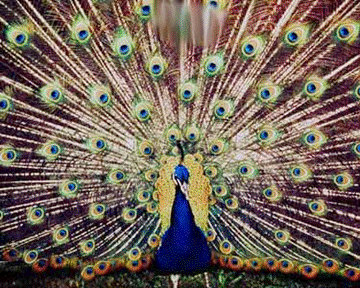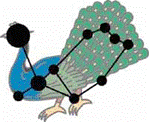
Peafowl don’t mix well with other animals. They can be aggressive if in danger and have fierce tempers when provoked. They need space to roam; males are territorial.

|
Peahens – females |
Peacocks – males |
|
Peachicks – young fowl |
Peafowl – general name |
To view other pictures of peafowl, log-on to the sites below:
Peafowl have been kept in captivity for over 4000 years because of the extraordinary beauty of the peacocks.

JUNO, queen of the gods, had the fairest cow that any one ever saw. She was creamy white, and her eyes were of as soft and bright a blue as those of any maiden in the world. Juno and the king of the gods often played tricks on each other, and Juno knew well that the king would try to get her cow. There was a watchman named Argus, and one would think that he could see all that was going on in the world, for he had a hundred eyes, and no one had ever seen them all asleep at once, so Queen Juno gave to Argus the work of watching the white cow.
The king of the gods knew what she had done, and he laughed to himself and said, “I will play a trick on Juno, and I will have the white cow.” He sent for Mercury and whispered in his ear, “Mercury, go to the green field where Argus watches the cream-white cow and get her for me.”
Mercury was always happy when he could play a trick on any one, and he set out gladly for the field where Argus watched the cream-white cow with every one of his hundred eyes.
Now Mercury could tell merry stories of all that was done in the world. He could sing, too, and the music of his voice had lulled many a god to sleep. Argus knew that, but he had been alone a long time, and he thought, “What harm is there in listening to his merry chatter? I have a hundred eyes, and even if half of them were asleep, the others could easily keep watch of one cow.” So he gladly hailed Mercury and said, “I have been alone in this field a long, long time, but you have roamed about as you would. Will you not sing to me, and tell me what has happened in the world? You would be glad to hear stories and music if you had nothing to do but watch a cow, even if it was the cow of a queen.”
So Mercury sang and told stories. Some of the songs were merry, and some were sad. The watchman closed one eye, then another and another, but there were two eyes that would not close for all the sad songs and all the merry ones. Then Mercury drew forth a hollow reed that he had brought from the river and began to play on it. It was a magic reed, and as he played, one could hear the water rippling gently on the shore and the breath of the wind in the pine-trees; one could see the lilies bending their heads as the dusk came on, and the stars twinkling softly in the summer sky.
It is no wonder that Argus closed one eye and then the other. Every one of his hundred eyes was fast asleep, and Mercury went away to the king of the gods with the cream-white cow.
Juno had so often played tricks on the king that he was happy because he had played this one on her, but Juno was angry, and she said to Argus, “You are a strange watchman. You have a hundred eyes, and you could not keep even one of them from falling asleep. My peacock is wiser than you, for he knows when any one is looking at him. I will put every one of your eyes in the tail of the peacock.” And today, whoever looks at the peacock can count in his tail the hundred eyes that once belonged to Argus.
 Re-read pages 37 – 39 about Esperanza and Chica’s scuffle with a peacock named Zafiro at the Ochoa’s party. Record information you learn about peacocks not included in the Peafowl Facts Sheet. Re-read pages 37 – 39 about Esperanza and Chica’s scuffle with a peacock named Zafiro at the Ochoa’s party. Record information you learn about peacocks not included in the Peafowl Facts Sheet. |
Read one of the bookson peafowl and share what you learned during your next lit circle meeting.~The Spooky Tale of Prewitt Peacock by Bill Peet ~Just Plain Fancy by Patricia Polacco ~Feathers and Fools by Mem Fox ~A Peacock on the Lawn by Anna Hadfield |
Re-read pages 37 – 39 about Esperanza and Chica’s scuffle with a peacock named Zafiro at the Ochoa’s party. Record information from the Peafowl Facts Sheet that verifies Esperanza’s claim to Papá that the peacock chased her and that Chica was only rescuing her. |
| Read the myth, “Why the Peacock’s Tail has a Hundred Eyes.” Retell the myth to a friend or family member. |  Research the Peacock Constellation. Write a summary of your findings and post it in the classroom for others to read. Research the Peacock Constellation. Write a summary of your findings and post it in the classroom for others to read. |
Read the Peafowl in History Sheet and make a chart outlining how different cultures used and viewed the peacock as part of their lives or in their storytelling – myths and legends. |
| Use an online dictionary to look up the boldfaced words located in the Peafowl Facts Sheet and the Peafowl in History Sheet. Write the definitionson flashcards. | Write a creative story about a party or bevy of peafowl. Weave information you have learned from the Peafowl Center into your story. Illustrate it as an option. Share the story with a friend, your teacher or a family member. | Research the use of peacock feathers to adorn clothing and head wear throughout history. Create a piece of art using peacock feathers in your design. |